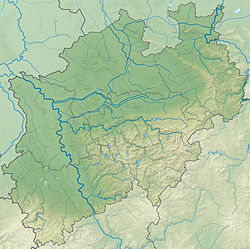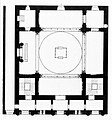Glockengasse Synagogue
| Glockengasse Synagogue | |
|---|---|
 | |
| Religion | |
| Affiliation | Judaism (former) |
| Ecclesiastical or organisational status | Synagogue (1861–1938) |
| Status | Destroyed |
| Location | |
| Location | Cologne, North Rhine-Westphalia |
| Country | Germany |
Location of the destroyed synagogue in North Rhine-Westphalia | |
| Geographic coordinates | 50°56′17″N 6°57′05″E / 50.93806°N 6.95139°E |
| Architecture | |
| Architect(s) | Ernst Friedrich Zwirner |
| Type | Synagogue architecture |
| Style | Moorish Revival |
| Funded by | |
| Destroyed | November 9, 1938 (on Kristallnacht) |
| Specifications | |
| Dome(s) | One central; four smaller |
| Dome height (outer) | 40 m (130 ft) |
| Dome dia. (outer) | 10 m (33 ft) |
The Synagogue in Glockengasse was a Jewish synagogue, that was located in Cologne, in the state of North Rhine-Westphalia, Germany. Designed by Ernst Friedrich Zwirner in the Moorish Revival style, the synagogue was completed in 1861 and destroyed by Nazis on November 9, 1938, during Kristallnacht.
Overview
[edit]Zwirner, the architect of the Cologne Cathedral, built the synagogue on the site of the former Monastery of St. Clarissa, where a modest hall of prayer had been erected in the years of the French occupation and was closed in 1853 because it was unsafe.[1]: 240
On June 10, 1856, after much discussion in the Jewish communal executive board about whether it was better to build a synagogue in the same or a different spot, Abraham Oppenheim, son of Salomon Oppenheim, Jr., announced his readiness to erect a synagogue worthy of the Glockengasse at his own cost as a gift to the community. Drucker-Emden, a member of the Jewish communal administration, supported the decision.
The cornerstone was laid on June 23, 1857.[2]: 284 On August 29, 1861, there was a procession from the provisional synagogue on St. Apernstrasse along Breitestrasse and Kolumbastrasse to the new synagogue. The synagogue was dedicated to Rabbi Israel Schwarz. A memorial tablet dedicated to the donor was placed inside and a medal of silver and bronze was struck.[3]
In June 1867, fire damaged the building.[2]: 285 In the same year Albert, the son of Simon Oppenheim, Abraham’s brother, and his wife sold a piece of land on the south side of the synagogue and a strip on the east to the Jewish community, making it possible to enlarge the synagogue, erect a smaller synagogue for week-day services, and leave room for a court.[1]: 242–243
The fiftieth anniversary of the synagogue was celebrated in 1911. During World War I, the large cupola, as well as the smaller ones, were stripped of their original copper covering. The cupolas had been regarded as among the most beautiful in Cologne because of the patinated copper. In consequence of the removal, the four towers on the outside pillars were dismantled and only restored in 1925, while the replacement of the copper covering was postponed for financial reasons.[1]: 243
The synagogue was destroyed during the Kristallnacht on November 9, 1938 together with the other synagogues in Cologne.[4] The modernist Cologne Opera House now occupies the site. A bronze plaque on its façade on Offenbachplatz commemorates the synagogue.
The synagogue has been recreated in virtual form.[5][6]
Architecture
[edit]Floor plan
[edit]It was the first example of a central plan over a Greek cross covered by a dome.[2]: 284 The four arms of the cross had the same length, as in Byzantine architecture buildings. Through the association of a cross form with a square room emerged on the corners. The rooms on the side of the façade hold the staircases to the ladies gallery.[2]: 287
The dome was inscribed in the central square, in the middle of which stood the bimah.[2]: 285 The central position of the bimah shows that the Jewish community was attached to the old tradition, while the Roonstrasse Synagogue had a new floor plan, that was developed according to the Reform Judaism beliefs.[2]: 287
A low wing of the entrance hall was built with five rooms in front of the square building structure on the street side. The five rooms served as entrance to the staircases to the ladies gallery, as entrance for the men to the main synagogue and a space for the synagogue attendants (Shammes).
External architecture
[edit]A tall, protruding risalit was flanked on both sides by wings and was terminated on top by a merlon rim. Zwirner designed four small, minaret-shaped towers with small cupolas on top of the cornices, in contrast to the Leopoldstädter Tempel in Vienna, in which the towers were crowned by columns.[2]: 288
The rose window in the facade was a neo-Gothic feature.[2]: 289 Over the crossing there was a dome with windows all around. At the top was a lantern and an onion cupola. The cupola measured 40 metres (130 feet) in height and 10 m (33 ft) in diameter.
Internal architecture
[edit]The synagogue was, as already mentioned, a central building over a Greek cross, with a dome on top.[2]: 284 The four Byzantine cross arms of the same length of the synagogue were all equipped with a barrel vault,[2]: 290 in which the truss, the columns and the arches were made of cast iron. Except for the Eastern arm the other three arms were equipped with two floors of ladies galleries,[2]: 290 while the Torah ark was placed on the eastern arm, where the wall was decorated with stucco by Josef Hartzheim with rhombus and with a theme of intricate quadrangles and painted by Friedrich Petri of Gießen in blue, red and gold. The stucco work was related to the ones in Alhambra.[2]: 291
The ladies galleries were supported by six columns, that owing to the iron construction had a very fine and graceful form,[2]: 290 while the balustrade was decorated with stucco by Hartzheim and painted in gold by Petri. The four large arches, that supported the dome, were decorated by Hartzheim and painted by Petri in the same way as the eastern wall. The dome and the barrel vaults were the only structures that were not covered by stucco. They were painted by Petri in blue and decorated with golden stars.
"The windows were for the most part round, though some had the shape of a trefoil leaf. Through their colored glass a subdued light fell into the room and upon the richly decorated walls and pillars."[1]: 242
The Aaron haKodesch had been made by the Cologne sculptor Stephan, he used Carrara white marble and placed in the middle of the shrine a horse shoe arch.[2]: 291 Furthermore, Stephan inserted the capitals from Alhambra and the minaret tower composition with onion cupolas from the façade around the Aaron haKodesch. The water basin of the mikveh in the basement was also made by Stephan, and the same marble was used as for the Torah Ark.
The bimah in the middle of the synagogue room was somewhat higher than usual and stood directly under the cupola. It was surrounded by a parapet of rich woodwork.[1]: 242
Gallery
[edit]-
Plaque commemorating the synagogue
-
Floor plan of the synagogue
-
The synagogue during the 1860s
-
Glockengasse Synagogue
See also
[edit]References
[edit]- ^ a b c d e Kober, Adolf (1940). "Cologne". Philadelphia: The Jewish Publication Society of America.
- ^ a b c d e f g h i j k l m n Künzl, Hannelore (1984). "Zur Kölner Synagoge in der Glockengasse". Islamische Stilelemente im Synagogenbau des 19, und frühen 20, Jahrhunderts (in German). Lang, Frankfurt am Main u. a. ISBN 3-8204-8034-X. (Judentum und Umwelt, 9).
{{cite book}}: CS1 maint: postscript (link) - ^ "WEISS COLLECTION". www.historicalartmedals.com. Retrieved February 16, 2018.
- ^ "Photo". msacerdoti.it.
- ^ Marquis-Kyle, Peter. "Virtual German synagogues: Special places". www.marquis-kyle.com.au. Retrieved February 16, 2018.
- ^ "Art and Exhibition Hall: Exhibitions: Synagogues in Germany: A Virtual Reconstruction". KAH Bonn. Archived from the original on December 6, 2008.
External links
[edit]![]() Media related to Synagoge Glockengasse (Köln) at Wikimedia Commons
Media related to Synagoge Glockengasse (Köln) at Wikimedia Commons







